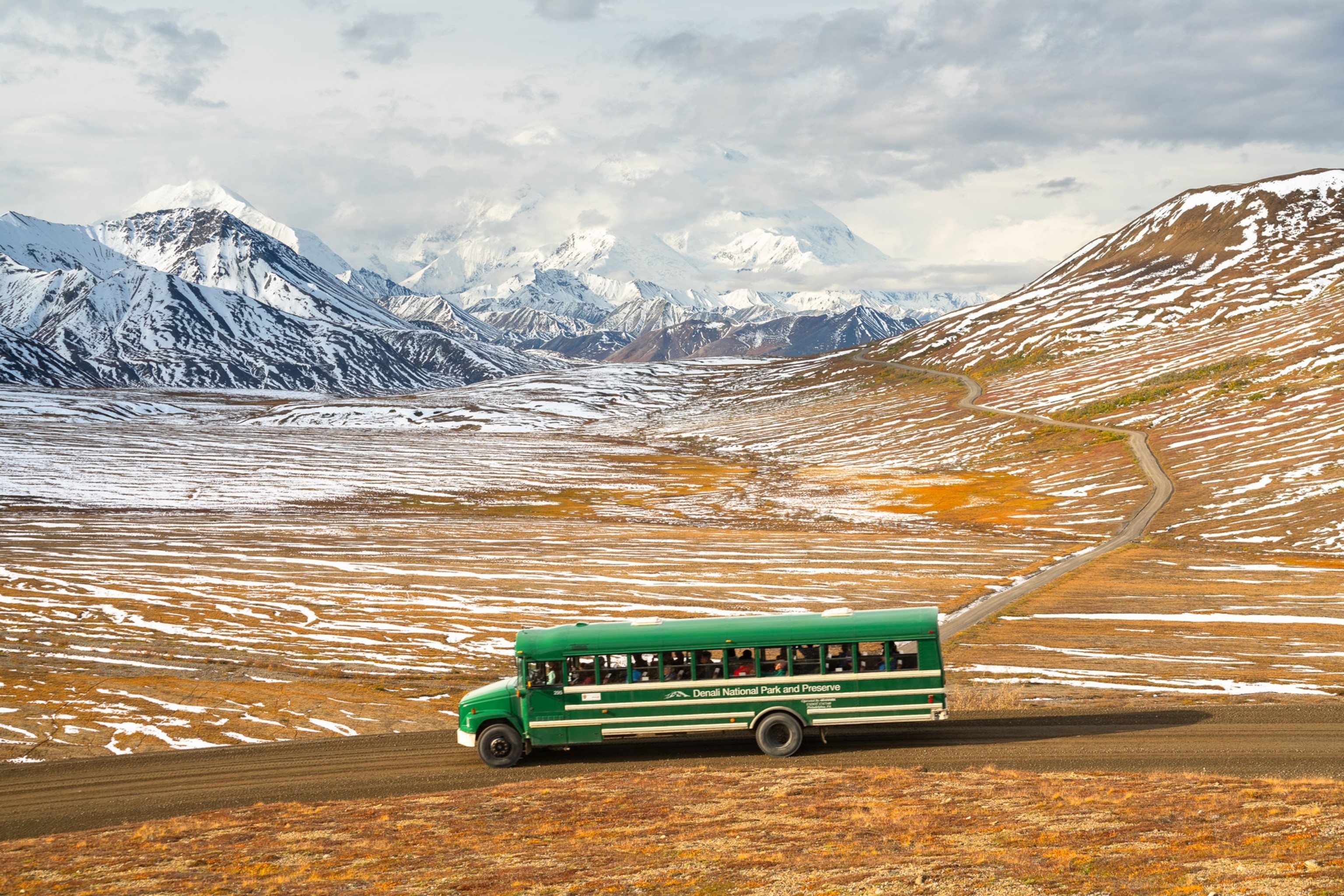Alaska Travel Guide is your gateway to the Last Frontier, offering invaluable insights for planning your dream trip. At CONDUCT.EDU.VN, we provide a comprehensive resource to navigate Alaska’s vast landscapes, ensuring a memorable and ethical journey. Explore responsible travel, sustainable practices, and ethical considerations in Alaska with our insights into ecotourism and conservation efforts.
1. Essential Alaska Travel Information
Before embarking on your Alaska adventure, it’s crucial to gather essential information to ensure a smooth and enjoyable trip. This section covers key details regarding statehood, capital, time zones, major airports, ferry ports, and railroad routes.
- Statehood: Alaska became the 49th state on January 3, 1959, marking a significant moment in its history.
- Capital: Juneau serves as the capital city of Alaska, located in the southeastern region.
- Time Zone: Alaska primarily operates on Alaska Standard Time (GMT-9 Daylight Savings). However, St. Lawrence Island and the Aleutian Islands of Atka, Adak, Attu, and Shemya observe Hawaii-Aleutian Standard Time (GMT-10 Daylight Savings).
- Main Airports:
- Ted Stevens Anchorage International Airport (ANC) is a major hub in Southcentral Alaska, offering flights to various domestic and international destinations.
- Fairbanks International Airport (FAI) serves Interior Alaska with commercial airlines operating during the summer and limited services in the winter.
- Juneau International Airport (JNU) and Ketchikan International Airport (KTN) are significant airports in Southeast Alaska.
- Ferry Ports: The Alaska Marine Highway ferries cover an extensive 3,500 miles, connecting major cities and remote communities.
- Railroad Routes: The Alaska Railroad provides services from Fairbanks to Seward during the summer, with limited winter service on the Aurora Winter route.
- Unique Fact: Only a small percentage of Alaska’s cities, towns, and villages are accessible by road, with the remaining areas reachable by boat or plane.
2. Why Alaska Should Be Your Next Travel Destination
Alaska beckons with millions of acres of pristine wilderness, rich Indigenous cultures, and the mesmerizing Northern Lights. Experience the thrill of the blanket toss and the satisfaction of fishing for king salmon, making your trip unforgettable.
- Dazzling Wilderness: Alaska’s vast, untouched landscapes provide unparalleled opportunities for exploration and adventure.
- Indigenous Cultures: Discover the vibrant heritage of the Dena’ina people in Anchorage and other Native communities throughout the state.
- Northern Lights: Witness the breathtaking Aurora Borealis dancing across the night sky, especially in areas like Fairbanks.
- Unique Experiences: Participate in traditional activities like the blanket toss and enjoy world-class fishing for king salmon.
3. The Best Times to Visit Alaska
Choosing the right time to visit Alaska can significantly enhance your experience. Summer offers long daylight hours for outdoor activities, while winter provides opportunities to witness the Northern Lights and enjoy winter sports.
3.1 Summer (June-August)
Summer in Alaska is a period of endless daylight, offering visitors the chance to immerse themselves in various outdoor adventures.
- Activities: Fish for sockeye salmon, backpack in the Chugach Mountains, or explore Wrangell-St. Elias National Park.
- Wildlife: Observe abundant wildflowers, berries, and bears.
- Travel: Cruises, RVs, and bush planes are popular modes of transport during the summer months.
- Note: Be prepared for mosquitoes.
3.2 Winter (December-February)
Winter transforms Alaska into a snowy wonderland, perfect for those seeking unique experiences and stunning displays of the Aurora Borealis.
- Activities: Fat tire biking, skiing (cross-country and heli-skiing), and attending the Iditarod dog sled race.
- Cultural Experiences: Visit the Sealaska Heritage Center to learn about Southeast Alaska’s Indigenous communities.
- Note: Winter service may be limited for some transportation options.
3.3 Fall and Spring (Shoulder Seasons)
Fall and spring are considered shoulder seasons in Alaska, each with its own characteristics.
- Fall: Although the fall foliage is beautiful, the season is short, and Alaskans are typically preparing for winter.
- Spring: Known as “breakup,” spring tends to be muddy as the ice and snow melt, making it less ideal for visiting.
4. Exploring Alaska’s Diverse Regions
Alaska is divided into several distinct regions, each offering unique landscapes, activities, and cultural experiences.
4.1 Cities
Alaska’s cities provide a blend of cultural attractions, culinary delights, and access to the state’s vast wilderness.
- Juneau: The capital city, bustling during the legislative session (January to May).
- Anchorage: Features a vibrant arts scene and excellent food.
- Fairbanks: Home to a key community hub with its farmers market and the iconic UAF outdoor thermometer.
4.2 Arctic
The Arctic region of Alaska offers a remote and unparalleled experience, characterized by unique landscapes and modes of transportation.
- Transportation: Travel between communities is typically by bush plane, skiffs, or snow machines in the winter.
- Dalton Highway: Drive or take a guided tour along the Dalton Highway across the Arctic Circle.
4.3 Southcentral
Southcentral Alaska is the most populated region, offering a mix of urban amenities and access to stunning natural landscapes.
- Attractions: Bear viewing in Homer, day cruises from Valdez, and hiking in Chugach National Forest.
4.4 Interior
The Interior is dominated by the Alaska Range to the south and the Brooks Range to the north, featuring Denali Mountain and its namesake park.
- Denali Highway: A thrilling route for geology and archaeology enthusiasts.
4.5 Southeast
The Inside Passage is home to charming small towns with plenty of character.
- Ketchikan: Known for its public art.
- Sitka: Features a rich Russian heritage and cozy bookstores.
4.6 Southwest
Southwest Alaska is characterized by small communities and vast tracts of wilderness.
- Birding: Visit Adak and the Pribilof Islands for exceptional birdwatching opportunities.
- Bristol Bay: Renowned for its rich sockeye salmon waters.
5. Transportation Options in Alaska
Navigating Alaska requires careful planning due to its vast size and varied terrain. Several transportation options are available to suit different travel needs and preferences.
- By Plane: Alaska Airlines offers flights to numerous locations throughout the state. Smaller commuter lines and charter flights provide access to more remote areas.
- By Train: The Alaska Railroad operates between Fairbanks and Seward during the summer, with limited winter service.
- By Car: Rental cars are available in major cities and some towns in the Southeast. The Alaska Marine Highway system is essential for driving between certain regions. Be prepared for potential delays due to limited road systems and summer road repairs.
- By Boat: The Alaska Marine Highway ferry system connects Bellingham, Washington, with Southcentral Alaska and the Aleutian Chain. Booking in advance is highly recommended.
6. Essential Tips Before You Go
Planning ahead is crucial when visiting Alaska. Consider booking tours, accommodations, and rental cars well in advance, especially during the peak summer season.
- Cultural History: Alaska has been home to 11 distinct cultures for thousands of years. The Eyak, Tlingit, Haida, and Tsimshian peoples come from Southeast. North and northwest are the lands of the Iñupiat and St. Lawrence Island Yup’ik. The Interior is home to 11 linguistic groups of the Athabascan people. In Southwest, the Yup’ik and Cup’ik people have fished the local waters for millennia. The Alutiiq and Unangax peoples have long inhabited Southcentral and the Aleutian chain.
- Reservations: Book tours, hotel rooms, and rental cars at least six months in advance for summer travel.
- Hours: Restaurant hours may vary, especially during the winter months.
- LGBTQ+: While Alaska ranks 27th in LGBTQ+-friendly states, cities like Anchorage and Juneau have ordinances protecting sexual orientation and gender identity.
7. Sustainable and Responsible Travel in Alaska
Alaska’s pristine environment requires a commitment to sustainable and responsible travel practices.
- Outdoors: Adhere to “leave no trace” principles and support eco-certified businesses through programs like Adventure Green Alaska. Follow the Fish and Game Department’s guidelines when viewing wildlife.
- Shopping: Look for the “Made in Alaska” and “Silver Hand” symbols to ensure you are purchasing authentic, locally made products.
- Dining: Support restaurants that prioritize locally sourced seafood and produce.
8. Recommended Reading and Viewing
Immerse yourself in Alaska’s culture and environment through these recommended books and shows:
- Hyperboreal by Joan Naviyuk Kane: Poetry exploring the history of King Island.
- If You Lived Here, I’d Know Your Name by Heather Lende: A memoir about life in small-town Alaska.
- Berry Song by Michaela Goade: A children’s book highlighting the subsistence lifestyle of Alaska Native people.
- Life Below Zero: A Nat Geo series exploring the challenges of living in remote Alaska.
9. Nat Geo Expeditions
Explore Alaska with National Geographic Expeditions, offering itineraries ranging from wildlife watching in national parks to cruising the Inside Passage.
10. Alaska Travel FAQs
10.1 What is the best time to see the Northern Lights in Alaska?
The best time to see the Northern Lights in Alaska is during the winter months, from September to April. Clear, dark skies are essential for optimal viewing.
10.2 How do I get around Alaska without a car?
You can travel by plane, train, or ferry. Alaska Airlines offers flights to many locations, and the Alaska Railroad and Alaska Marine Highway provide alternative transportation options.
10.3 What should I pack for a summer trip to Alaska?
Pack layers of clothing, including waterproof outerwear, comfortable hiking shoes, insect repellent, sunscreen, and a hat.
10.4 Are there bears in Alaska? How can I stay safe?
Yes, Alaska is home to bears. Store food properly, carry bear spray, make noise while hiking, and maintain a safe distance from wildlife.
10.5 What are some must-see national parks in Alaska?
Denali National Park and Preserve, Wrangell-St. Elias National Park and Preserve, and Kenai Fjords National Park are among the must-see national parks in Alaska.
10.6 How can I experience Alaska Native culture respectfully?
Visit cultural centers, attend local events, and support Native-owned businesses. Always ask permission before photographing people or ceremonies.
10.7 What is the Alaska Marine Highway System?
The Alaska Marine Highway System is a ferry service connecting communities throughout coastal Alaska, offering a unique way to explore the region.
10.8 What are some popular activities in Anchorage?
Popular activities in Anchorage include visiting the Anchorage Museum, hiking the Tony Knowles Coastal Trail, and exploring the local food scene.
10.9 How can I travel sustainably in Alaska?
Support eco-certified businesses, follow “leave no trace” principles, and respect wildlife and their habitats.
10.10 What are the best places to go fishing in Alaska?
Bristol Bay, the Kenai River, and Southeast Alaska are renowned for their exceptional fishing opportunities.
11. The Importance of Ethical Travel in Alaska
As you plan your trip, consider the ethical implications of your travel choices. Supporting local communities, respecting Indigenous cultures, and minimizing your environmental impact are crucial for responsible tourism.
- Support Local Businesses: Choose accommodations, tours, and restaurants that are locally owned and operated.
- Respect Indigenous Cultures: Learn about the history and traditions of Alaska Native communities and engage respectfully with their culture.
- Minimize Environmental Impact: Practice sustainable travel habits, such as reducing waste, conserving resources, and avoiding single-use plastics.
12. Exploring Alaska’s Wilderness Responsibly
Alaska’s vast wilderness areas offer incredible opportunities for adventure, but it’s essential to explore them responsibly.
- Leave No Trace: Pack out everything you pack in, stay on marked trails, and avoid disturbing wildlife or vegetation.
- Respect Wildlife: Observe animals from a safe distance and never feed them. Store food properly to avoid attracting bears or other wildlife.
- Be Prepared: Check weather conditions, bring appropriate gear, and inform someone of your travel plans before heading into the backcountry.
13. Supporting Conservation Efforts in Alaska
Many organizations are dedicated to protecting Alaska’s natural resources and wildlife. Consider supporting their efforts through donations or volunteer work.
- Alaska Conservation Foundation: Supports a variety of conservation initiatives throughout the state.
- Audubon Alaska: Works to protect birds and their habitats.
- The Nature Conservancy in Alaska: Focuses on preserving Alaska’s biodiversity and natural landscapes.
14. Planning Your Eco-Friendly Alaska Adventure
Creating an eco-friendly itinerary involves making conscious choices about transportation, accommodations, and activities.
- Transportation: Opt for train or bus travel whenever possible to reduce your carbon footprint.
- Accommodations: Choose eco-friendly lodges or hotels that prioritize sustainability.
- Activities: Participate in guided tours that focus on conservation and responsible wildlife viewing.
15. Understanding Alaska’s Cultural Landscape
Alaska is home to a diverse range of cultures, each with its own unique traditions and history. Take the time to learn about and appreciate the cultural landscape of Alaska.
- Alaska Native Cultures: Explore the history, art, and traditions of Alaska Native communities by visiting cultural centers, museums, and local events.
- Russian Heritage: Discover the influence of Russian culture in communities like Sitka, which was once the capital of Russian America.
- Pioneer History: Learn about the pioneers who shaped Alaska’s modern history by visiting historical sites and museums.
16. The Role of CONDUCT.EDU.VN in Promoting Ethical Travel
CONDUCT.EDU.VN is committed to providing travelers with the information and resources they need to make ethical and responsible choices. Our guides, articles, and resources cover a wide range of topics, including sustainable travel practices, cultural sensitivity, and conservation efforts.
- Ethical Guidelines: We provide guidelines for travelers on how to interact respectfully with local communities and minimize their environmental impact.
- Responsible Tourism: We promote responsible tourism by highlighting businesses and organizations that prioritize sustainability and ethical practices.
- Education: We educate travelers about the importance of ethical travel and encourage them to make informed decisions that benefit both the environment and local communities.
17. Connecting with Local Communities in Alaska
One of the most rewarding aspects of travel is connecting with local communities and learning about their way of life.
- Attend Local Events: Participate in community festivals, markets, and cultural events to experience Alaska’s vibrant local culture.
- Visit Local Businesses: Shop at local stores, eat at family-owned restaurants, and support small businesses to contribute to the local economy.
- Engage with Residents: Take the time to talk to locals and learn about their experiences and perspectives.
18. Practical Tips for Responsible Wildlife Viewing
Alaska’s wildlife is one of its greatest attractions, but it’s essential to view animals responsibly to avoid disturbing them or their habitats.
- Maintain a Safe Distance: Use binoculars or a telephoto lens to observe wildlife from a distance.
- Avoid Feeding Animals: Feeding wildlife can alter their natural behavior and make them dependent on humans.
- Respect Habitats: Stay on marked trails and avoid disturbing nesting sites or other sensitive areas.
19. Minimizing Your Environmental Footprint
Traveling sustainably involves making conscious choices to reduce your environmental impact.
- Reduce Waste: Bring reusable water bottles, shopping bags, and food containers to minimize waste.
- Conserve Resources: Turn off lights and appliances when you leave your accommodation and conserve water whenever possible.
- Support Sustainable Practices: Choose businesses and organizations that are committed to reducing their environmental footprint.
20. Embrace the Spirit of Adventure in Alaska
Alaska offers endless opportunities for adventure, but it’s essential to approach these experiences with respect and responsibility.
- Explore Responsibly: Choose activities that have minimal impact on the environment and support local communities.
- Respect Nature: Appreciate the beauty of Alaska’s natural landscapes and do your part to protect them for future generations.
- Connect with the Culture: Immerse yourself in Alaska’s diverse cultures and learn from the experiences of local residents.
At CONDUCT.EDU.VN, we believe that ethical travel can enhance your experience and contribute to a more sustainable future for Alaska. We invite you to explore our website for more information and resources to help you plan your dream trip. For additional guidance, contact us at 100 Ethics Plaza, Guideline City, CA 90210, United States, Whatsapp: +1 (707) 555-1234, or visit our website: conduct.edu.vn. Let us help you make your Alaska adventure both memorable and meaningful.
 Alaska mountain range
Alaska mountain range
Visitors in Denali National Park are taking in the breathtaking views of the majestic Alaska mountain range, highlighting the park’s scenic beauty.
Remember to book your tours, accommodation, and rental cars well in advance to make the most of your Alaska adventure.

